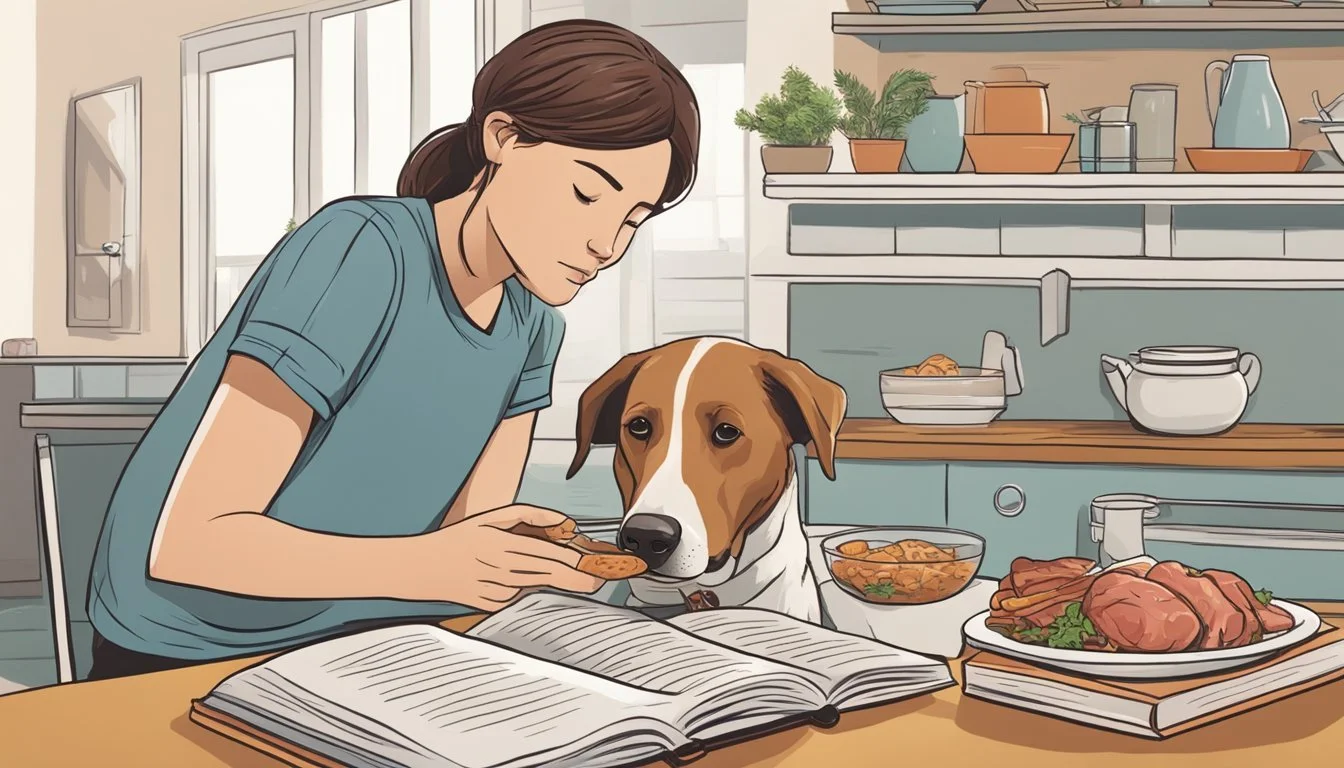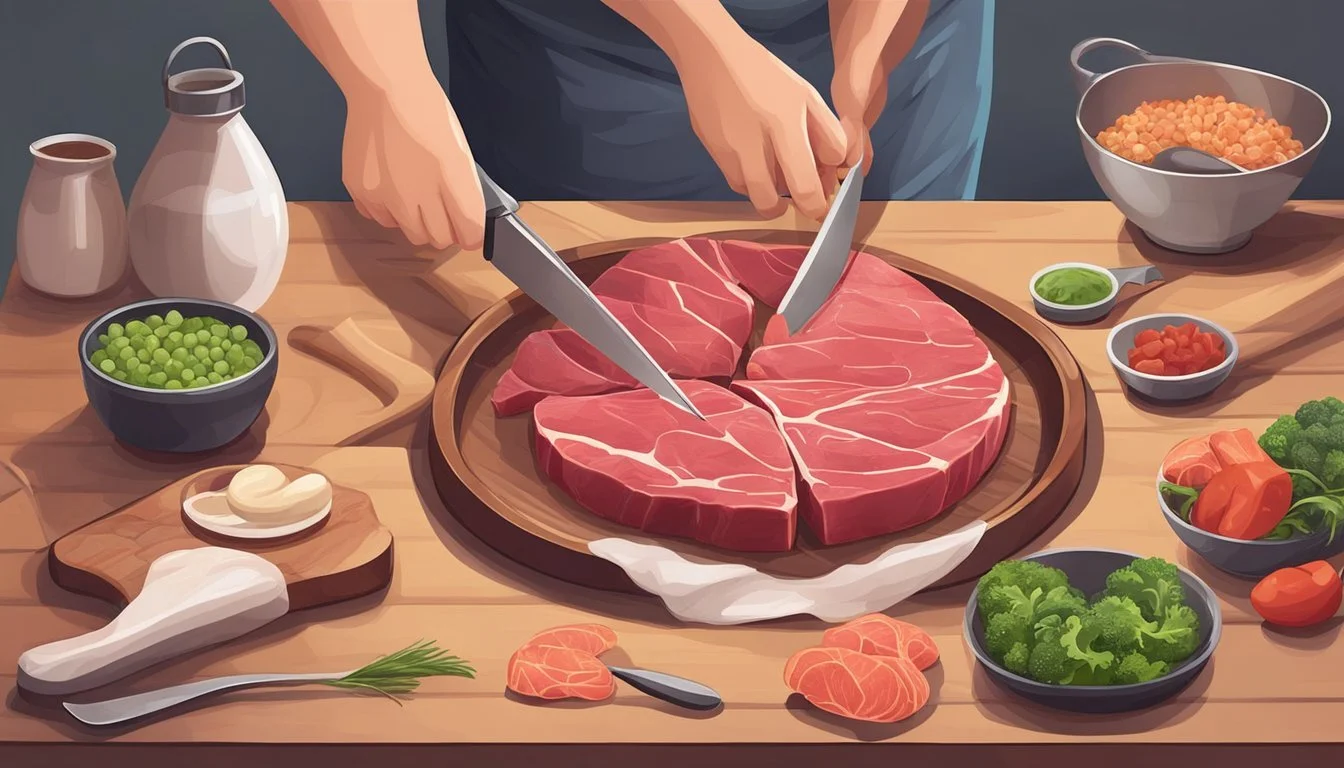The Carnivore Diet for Pet Owners
Ensuring Your Pets Thrive While You Maintain Your Diet
As pet owners explore various nutrition options for their companions, the carnivore diet has emerged as a preference for many, aligning more closely with the evolutionary eating patterns of dogs. This meat-centric diet comprises primarily animal products, which supporters believe cater to the biological needs of their pets. Advocates of the carnivore diet argue that it can lead to a range of health benefits, including improved energy levels, healthier skin and coat, and better overall well-being due to its alignment with a dog's natural dietary inclinations.
While the concept of a carnivore diet for dogs might seem straightforward, the practical aspects of integrating such a diet within the household can pose challenges, particularly when the pet owner follows a different eating regimen. Balancing a personal diet that may lean towards vegetarianism or veganism with the meat-heavy dietary requirements of a pet carnivore involves a thoughtful approach to meal planning and preparation. Responsible pet care demands that the owners ensure their dietary choices for their pets are informed, balanced, and respectful of their pets' health needs.
Thus, it becomes paramount for pet owners to be well-informed about the nutritional needs of their carnivorous pets. Ensuring a balanced carnivore diet for a pet requires a comprehensive understanding of the required nutrients, appropriate food sources, and portion sizes to promote optimal health. It's not simply a matter of serving meat; it's about crafting a diet that supports the pet's health while considering the practicalities of the owner's lifestyle and dietary preferences.
Understanding the Carnivore Diet
This section examines the core tenets of the carnivore diet, differentiates the approach taken by humans versus pets, and traces its historical background in the context of pet nutrition.
Principles of the Carnivore Diet
The carnivore diet revolves around the idea that animals thrive on meat-based nutrition. Carnivores depend on a high-protein intake that provides the essential energy and building blocks for health and well-being. A species-appropriate diet for carnivorous pets typically has high protein content, moderate to low fat, and minimal carbohydrates.
Carnivore Diet for Humans vs. Pets
While both humans and pets may follow a carnivore diet, there are important distinctions.
Humans opt for this diet for reasons such as weight loss, mental clarity, or as an ancestral health approach.
Pets, on the other hand, usually require a carnivorous diet as it mirrors their natural diet more closely. Dogs and cats, for example, have evolved to digest and utilize meat-based diets efficiently.
History and Origin of Carnivorous Diets in Pets
Carnivorous diets have a longstanding presence in the animal kingdom.
For domestic pets, a meat-centric diet is not a human-invented regimen but rather a reflection of their ancestral feeding patterns.
Recent trends towards commercial pet foods have only shifted away from these natural diets over the last century. Today, a rising number of pet owners are embracing a return to meat-based diets due to the perceived alignment with their pets' evolutionary needs.
Benefits and Risks of Carnivore Diets
Embracing a carnivore diet can have a significant impact on health, including potential benefits and risks which need to be carefully weighed. This is particularly important when balancing personal dietary choices with the responsibility of pet care.
Health Advantages for Pets
Pets, especially cats and dogs, can experience substantial health advantages when fed a meat-based diet that aligns with their evolutionary nutritional needs. Cats are obligate carnivores and thrive on a diet rich in animal proteins and fats, which support muscle development and energy requirements. Dogs, although more omnivorous, also benefit from animal-sourced nutrients for optimal health and digestion. Diets that are high in quality meats can enhance pet mood and mental health, and may contribute to the maintenance of a healthy weight.
Key Nutrients:
Protein: Sustains tissue repair and muscle growth.
Fats: Provides energy and aids in nutrient absorption.
Potential Health Risks
However, the exclusive focus on animal products can pose health risks if not properly managed. Pets may suffer from nutrient imbalances if the diet lacks variety, potentially leading to chronic illnesses. Excessive intake of particular nutrients, such as fats, may also increase the risk of obesity and related diseases like diabetes and arthritis in pets. Furthermore, certain additives in processed meats designed for human consumption may cause inflammation or even contribute to the development of cancer.
Risks to Consider:
Nutritional Imbalances: Can lead to health issues over time.
Additives: May trigger inflammatory responses.
Balancing Nutritional Needs
For both pets and owners following a carnivore diet, balancing nutritional needs is vital. Ensuring that the animal-sourced foods provided contain all necessary nutrients helps maintain overall health and prevent disease. This includes a careful selection of meat that minimizes the intake of harmful additives, the consideration of any necessary supplementation, and the regular monitoring of health parameters to prevent the onset of obesity or other diet-related conditions.
Considerations for Nutritional Balance:
Variety and Quality: Select high-quality meats and consider supplementing if needed.
Monitor Health: Regular check-ups to prevent and manage health conditions.
Pet Carnivore Diet Implementation
When transitioning a pet to a carnivore diet, it's essential to consider their specific dietary needs, monitor their health closely, and consult with a veterinarian for professional guidance.
Switching Your Pet to a Carnivore Diet
To switch your pet to a carnivore diet, gradually introduce meat-based pet foods while phasing out their current diet. It is vital to pay attention to the following aspects:
Size and Digestive System: Smaller breeds may require more frequent, smaller meals, while larger breeds can handle larger portions. It's important to adjust the meal size to your pet's digestive physiology.
Species-Specific Needs: Dogs have distinct nutritional requirements; their carnivore diet should be rich in proteins and fats to align with their species-specific needs.
A study-supported approach can provide a framework for the quantity and type of meats suitable for your pet's health. Incorporate meats into the diet slowly over a week or two, observing for any adverse reactions or digestive issues.
Monitoring Health and Well-Being
While pets are on a carnivore diet, regular health assessments are critical:
Physical Health: Observe your pet’s energy levels, weight, and coat condition. Positive changes may indicate a successful dietary transition.
Behavior: Monitor their mood and engagement, as a carnivore diet can affect these.
Keep a diary or a table tracking these changes:
Week 1
Weight: X lbs
Coat Condition: Y description (e.g., shiny, dull, shedding)
Energy Levels: Z observation (e.g., lethargic, normal, hyperactive)
Mood: A state (e.g., anxious, content, aggressive)
Week 2
Weight: X lbs (note any changes from previous week)
Coat Condition: Y description (update based on changes or improvements)
Energy Levels: Z observation (note any differences from week 1)
Mood: A state (describe any mood changes or consistencies)Consistency in documentation helps identify patterns and potential health issues.
Consulting with a Veterinarian
Consulting with a veterinarian is a key step in the diet transition process:
Initial Consultation: A pre-diet consultation helps tailor the diet to your pet’s individual needs and lifestyle.
Regular Check-ups: Ongoing veterinary supervision ensures that the diet meets your pet's nutritional requirements and addresses any arising health issues.
Veterinarians can provide knowledge on the latest studies and offer species-specific advice. They are equipped to understand your pet’s physiology and can identify potential risks specific to carnivore diets. Always follow a veterinarian’s recommendation when making dietary changes.
Species-Specific Nutritional Needs
Proper nutrition is pivotal for the health of pets, and understanding the dietary needs specific to cats and dogs helps ensure they thrive. Their requirements vary, especially between species, highlighting the importance of species-appropriate diets.
Cats as Obligate Carnivores
Cats are obligate carnivores, meaning their physiology is fine-tuned to derive nutrition primarily from animal-based proteins. Essential nutrients for cats include taurine, an amino acid; arachidonic acid, a fatty acid; as well as vitamins A and D, which they cannot synthesize from plant sources efficiently. Cats require high levels of protein, and lack the digestive enzymes to break down carbohydrates effectively.
Amino Acids: Essential for cats, especially taurine. Deficiency can lead to serious health issues.
Fats: Necessary for energy, with arachidonic acid being specifically important.
Vitamins & Minerals: Cats require a dietary source of vitamin A and D, and minerals like calcium.
Dogs' Flexibility With Diets
Dogs, while also carnivores, have a digestive system more adaptable to a variety of foods, including both animal and some plant materials. Evolutionarily connected to wolves, domestic dogs have developed the ability to process carbohydrates better than their ancestral counterparts. However, the basis of their diet should still be high in proteins and fats, particularly omega-3 and omega-6 fatty acids.
Protein & Fats: Form the cornerstone of a dog's diet but can come from a variety of sources, including plants.
Carbohydrates: Can be included in a dog's diet in moderation, provided the dog does not have any specific health issues that prohibit them.
Enzymes: Dogs produce amylase, an enzyme that allows them to digest carbohydrates.
Nutrient Requirements for Different Breeds
Although there are general guidelines for canines and felines, specific breeds may have unique dietary needs. For example, larger dog breeds might require different balances of minerals such as calcium and phosphorus for bone health, while some might need more or fewer calories depending on their activity level and metabolism.
Large Breeds: May need controlled levels of calories and minerals to prevent rapid growth that can lead to skeletal problems.
Active Breeds: Require diets rich in fats and protein to support their energy needs.
Small Breeds: Often need more nutrient-dense food as they have higher metabolic rates.
Common Concerns and Solutions
Transitioning to a carnivore diet for pets, particularly dogs, can lead to various initial concerns. Heeding to proper management can alleviate these issues effectively.
Managing Digestive Changes
When pets switch to a carnivorous diet, digestive changes such as gas and bloating may occur as their systems adapt. Introducing digestive enzymes can facilitate this shift, promoting a smoother transition. These enzymes aid in breaking down proteins and fats, reducing discomfort.
Solutions:
Gradually introduce the new diet over several weeks.
Add a vet-recommended enzyme supplement to aid digestion.
Allergies and Food Sensitivities
Pets may experience allergies or food sensitivities when exposed to new proteins. It's critical to identify the specific allergens and remove them from the diet.
Solutions:
Introduce one protein source at a time and monitor for reactions.
Consult a veterinarian for an allergy test if sensitivities persist.
Dealing with Picky Eaters
Some pets may reject the carnivore diet initially due to developed taste preferences. Persistence and variety are key in overcoming this hurdle.
Solutions:
Mix carnivore diet options with current favorites, gradually reducing the familiar food.
Offer a diverse range of proteins to pique their interest.
Exploring Alternative Feeding Approaches
Pet owners seeking the best for their canine companions often confront the challenge of choosing the most suitable diet. Factors, such as the nutritional value of raw versus cooked meat, the efficacy of homemade diets compared to commercial offerings, and the potential benefits of organic and natural foods, are crucial to consider.
Raw vs. Cooked Meat Diets
Raw carnivore diets for dogs are increasingly eminent for their perceived alignment with a dog's natural eating habits. Proponents believe that raw meat, bones, and organs closely mirror the nutrient profile dogs would consume in the wild. Raw diets may include:
Unprocessed muscle meats
Whole or ground bones
Conversely, cooked diets are sometimes favored for their convenience and perceived safety, mitigating concerns about pathogens. Cooked diets generally consist of:
Thoroughly-cooked meats
Vegetables
Grains (for those not strictly following a carnivore diet)
Commercial Pet Food vs. Homemade Diets
Commercial pet foods offer convenience and are designed to provide a complete and balanced diet for pets. They come in both dry kibble and wet food formats, and many are formulated to target specific life stages or health needs.
On the other hand, homemade diets allow for greater control over ingredients but require understanding of a dog's nutritional needs. They can be either cooked or raw and may be preferred by those who wish to avoid processed foods or certain additives found in commercial diets.
Organic and Natural Diet Options
The demand for organic pet foods has surged, as they are made from ingredients farmed without synthetic pesticides or fertilizers. Similarly, natural diets are free from artificial colors, flavors, and preservatives, mirroring a commitment to minimally-processed food options.
Potential benefits of organic and natural diets may include:
Less exposure to chemical residues
Fewer artificial ingredients
However, pet owners should consider the scientific consensus and veterinary advice when evaluating these alternative diet options.
Strategic Pet Diet Planning
In this section, pet owners will learn how to effectively plan meals, adjust diets for different life stages, and incorporate a balance of nutrients to support the health and well-being of their carnivorous pets.
Meal Planning and Preparation
Proper meal planning is paramount in maintaining a carnivorous diet for pets. Doing so ensures the pets receive the necessary nutrients for optimal health. Owners should prepare a schedule that accounts for protein intake, as it's the cornerstone of a carnivore diet. High-quality sources including grass-fed meats or organic meats are preferable. Preparing meals in advance can save time and help manage portions while keeping track of the nutrients that the pet consumes.
Weekly Meal Prep: Outline the quantity of meat and list any additional supplements required.
Safe Handling: Store raw meats at safe temperatures and follow hygiene protocols to prevent contamination.
Adjusting Diets for Life Stages
Different life stages require different dietary needs. Puppies and kittens need more calories and nutrients to fuel their growth, while older pets may need fewer calories and certain adjustments to support joint health.
Puppies/Kittens: Higher calorie intake, rich in protein and fat for development.
Adults: Balanced diet matching activity levels.
Seniors: Potentially reduced calorie intake, with supplements for joint health and digestive support.
Owners should consult a veterinarian to tailor the diet appropriately to the life stage of their pet.
Incorporating Variety and Balance
While a carnivore diet for pets predominantly consists of meat, they also benefit from a range of nutrients that can be found in other sources. Incorporating variety can prevent deficiencies and support overall health.
Proteins: Different sources (e.g., beef, chicken, fish) to provide a range of amino acids.
Vitamins and Minerals: Supplements or small amounts of other foods can be included under veterinary guidance.
Fiber: Although low in carnivorous diets, small amounts can aid digestion.
Balance is key, ensuring the pet is not overloaded with calories or specific nutrients at the expense of others. Pet owners should always strive for a balanced approach to the carnivore diet that promotes health and vitality.
Interactive Components of Pet Care
Engaging with pets through interactive components of care is crucial for their overall well-being. These interactions encompass not only physical exercise but also behavioral training that aligns with their diet, affecting their mental health.
Exercise and Physical Activity
Regular exercise is essential for a pet's physical health. Dogs, in particular, require daily activity to maintain a healthy weight and muscle tone.
Frequency: Daily walks or play sessions
Type: Varying activities such as fetch, running, or agility courses
Exercise should be tailored to the pet's age, breed, and health status.
Behavioral Training and Diet
Behavioral training is intricately linked to a pet's diet.
Consistency in feeding: Adherence to feeding schedules
Training rewards: Incorporating nutritious treats aligning with a carnivore diet, avoiding overfeeding
Proper training and diet reinforce desirable behaviors and prevent issues like food aggression and obesity.
The Role of Diet in Mental Health
The diet of a pet has a profound influence on their mental health. Pets on a balanced carnivore diet could exhibit:
Anxiety: Reduction in symptoms
Depression: Improvement in engagement and overall mood
Nutrient-rich foods may contribute to a more stable and happier state of mind.
Future Trends and Research
The landscape of pet nutrition is poised for significant advancement, driven by research on carnivore diets and innovations in the pet food industry.
Emerging Studies on Carnivore Diets
Researchers are becoming increasingly invested in understanding the full impact of carnivore diets on pets. Ongoing studies are focusing on both the benefits and potential risks associated with feeding pets a meat-only diet. As such diets gain popularity among pet owners, the demand for scientific evidence to support dietary choices grows. These studies aim to answer critical questions regarding long-term health effects, nutritional completeness, and the relevance of ancestral diets for today’s domesticated animals.
Innovations in Pet Food Industry
The pet food industry is responding to the carnivore diet trend by rolling out ingredient-specific formulas and biologically appropriate raw foods (BARF). Nutritional technologies are advancing to ensure that high-meat diets for pets are safe, pathogen-free, and nutritionally balanced. Companies are also developing new forms of food packaging and preservation to enhance convenience and shelf life, thereby making carnivore diet options more accessible to a broader audience of pet owners.
The Growing Knowledge of Pet Nutrition
As the field of companion animal nutrition expands, so does the collective understanding of what constitutes an optimal diet for different species. Knowledge dissemination is key, and pet owners are becoming more educated on the nuances of pet nutrition through scientific publications and veterinary guidance. Researchers are compiling more peer-reviewed studies, and these findings are directly influencing commercial pet food formulations as well as homemade diet preparations designed for pets.










